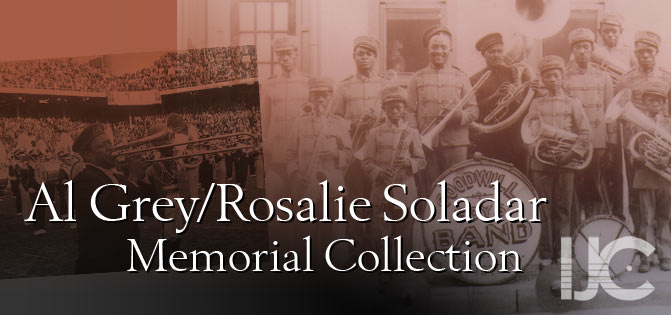Biography
Albert Thornton Grey was born on June 6, 1925 in Aldie, Virginia, just west of Washington DC. At three months of age his family moved to Pottstown, Pennsylvania, north of Philadelphia. The Grey home was filled with music which offered enticing temptations to Albert. At the age of four Albert started learning with his father’s trumpet. His father was an instructor for a youth orchestra in Pottstown. He played the baritone horn at school because Albert’s family was so poor they couldn’t afford an instrument for him. While attending school, Albert went from the baritone in middle school, to the E-flat tuba in junior high, then to the B-flat tuba in high school. Even as Albert played these instruments, he liked the sound of the band director’s trombone.
Albert joined the Navy during World War II and was sent to the Great Lakes Naval Training Center along with many other professional musicians of the time. During Albert’s time in the Navy, the tuba had become obsolete for jazz so he practiced the trombone in the bathroom. Albert was shipped out from the Great Lakes Naval Training Center to a Massachusetts ammunition depot and then to Grosse Isle Naval Air Station in Grosse Pointe, Michigan to be in the bands. While serving at these stations Albert frequented the nightclubs where he was known as The Sailor Boy.
Albert’s service to the Navy ended in 1946, and three days later he began playing for Benny Carter. Benny Carter heard that Albert was good and had just lost J. J. Johnson and needed a trombone player. “Benny Carter was like a teacher to Albert and if asked Albert always credited Benny Carter with extending his musical awareness.”1
“When Carter broke up his band late in 1946, Grey joined bandleader Jimmy Lunceford, where he took the seat once occupied by one of his idols, trombonist Trummy Young.”2 Albert enjoyed playing Trummy’s tunes while he was a member of Lunceford’s band. Albert lost the trombonist position when Jimmy unexpectedly died of a heart attack in the middle of a tour.
Albert joined vibraphonist, Lionel Hampton whose style was different from those of Carter and Lunceford. When he needed to draw some money, he made sure he played Cynthia which happened to be the favorite of Gladys Hampton, who managed Lionel’s purse strings. “He spent five years with Hampton, but was fired by the leader’s formidable wife, Gladys Hampton, for walking off stage one night when the band had overplayed a little too long (Grey had a date with a young lady).”2
Then, from 1956 to 1957, Albert worked in Dizzy Gillespie’s band. During this time bookings were scarce and transportation costs where high. Due to this the band had many nights without a gig. On one such night in 1957, Albert got the break he was looking for: Count Basie came to Philadelphia to the Pep’s Show Bar. Tom McIntosh was sick, so they had two trombone players. Basie was informed about Albert’s talent with the trombone and asked him to come play. Four days later they played a royal command performance in England. “His signature was the plunger mute, and he used it swaggeringly, making his malingering, behind-the-beat notes plump and juicy.”3
In Grey’s view, jazz wasn’t very complicated; it was just a way of expressing personal feelings to others. “So naturally, Grey is at his best in live performances, where he is able to reach out to an audience and hold it spellbound—and especially when he pulls out his trademark plunger.”4 “As a trombonist, he has mastered the art of the plunger, and he used it to accentuate the already acute rhythmic jumps and shudders that make his playing so involved and complicated.”5 The trombonist, Al Grey, died on March 24, 2000 at a hospital in Scottsdale, Arizona.

